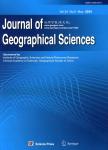Spatiotemporal changes in frequency and intensity of high-temperature events in China during 1961-2014
Spatiotemporal changes in frequency and intensity of high-temperature events in China during 1961-2014作者机构:Department of Geography Shanghai Normal University Shanghai 200234 China Key Laboratory of Watershed Geographic Sciences Nanjing Institute of Geography and Limnology CAS Nanjing 210008 China Shanghai Typhoon Institute China Meteorological Administration Shanghai 200030 China Department of Geology University of Dayton Dayton OH 45469 USA
出 版 物:《Journal of Geographical Sciences》 (地理学报(英文版))
年 卷 期:2017年第27卷第9期
页 面:1027-1043页
核心收录:
学科分类:0709[理学-地质学] 07[理学] 0704[理学-天文学]
基 金:National Natural Science Foundation of China No.41401603
主 题:high temperature heat waves extreme events climate change hiatus warming hole
摘 要:In this study, we explored spatial patterns and the temporal trends in high-temperature events (HTEs) for the mainland of China dudng 1961-2014 based on a dailymaximum surface-air-temperature dataset of 494 stations and nonparametric trend detection methods. With three thresholds of 35℃ (HTE35), 37℃ (HTE37), and 40℃ (HTE40), HTEs occurred in 82%, 71%, and 37% of the surveyed stations and showed an overall increasing trend in both frequency and intensity during 1961-2014. In northern and southeastem China, HTEs showed a significant increasing trend in both frequency and intensity, whilst a decreasing trend for both was observed in central China. Despite such regional heterogeneity, HTEs overwhelmingly presented three-phase characteristics in all three representative regions and throughout China; the phases are 1961-1980, 1980-1990, and 1990-2014. Both frequency and intensity of HTEs have strongly increased during 1990-2014 at 54.86%, 48.38%, and 23.28% of the investigated stations for HTE35, HTE37 and HTE40, respectively. These findings implied that HTEs adaptation should be paid further attention in the future over China because the wide spread distribution of HTEs and their increasing trends in both frequency and intensity during recent decades might pose challenges to the sustainability of human society and the ecosystem.



